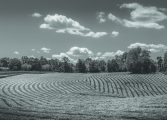By Page H. Gifford
Correspondent
For the second year in a row, the Fluvanna Art Association presented its round-robin with artists sharing their expertise and ideas with members in various mediums. Members were enthusiastic, having fun trying new techniques, and learning tips and tricks. Among the presenters were Mary Beth Pfieffer, Alyce Walcavich, Duffy Dillinger, and Page Gifford.
All the members broke up into groups and went around the room for a 20-minute demonstration. Gifford discussed and demonstrated the proper way to install hardware on a framed or unframed work and tips on framing and mats to give the featured work its best advantage.
Pfeiffer discussed and showed samples of woven beaded jewelry known at Kumihimo. Pfeiffer’s work was delicate and intricate. The current trend in fine jewelry is to use it as a foundation for gemstones. An ancient Japanese art form of Kumihimo was used by Samurai warriors as a functional and decorative way to lace their armor and their horses’ armor.
Kumihimo is a braiding technique that enables the artist to create custom chords using a braiding disc. It can be used for trims, cords, jewelry, and accessories. Pfeffer’s work shows the intricacy of using the technique with seed beads and the versatile beauty of this ancient art.
Walcavitch had an extensive demonstration featuring several methods for photo transfers. Many methods use photos done on a laser printer but not too many artists have one handy so the local copy machine is the best bet. But Walcavich also shared a variety of techniques using inkjet printers as well.
“These are unique handmade images which take some practice and are often experimental,” she said. “If you want a process that prints clear exact images, this process is probably not for you.” This process usually produces ghostly prints which when combined with other mixed media elements produce an ethereal feeling.
“You can print onto paper, wood, canvas, metal, and glass. Your sources for transfer can come from magazines, books, drawings, text, and photos from a laser or inkjet printer,” she said. “Use high contrast, and with color, increase the color saturation with the high-quality setting on the printer.”
One method is to use solvent, such as a blender pen or xylene applied to the back of the image, working in small areas, and then burnish it. She would lift it to see if it was transferred. If not she added more solvent. When the transfer is complete, remove the paper and let it dry completely. This method can also be done with acetone in a well-ventilated area. If toxic fumes are annoying, the solvent option may not be an option.
Less toxic, are other methods, including inkjet transfers with matte medium, acrylic paint, or water. There are two different ways paper backing transfers on a laser jet printer. The paper backing transfer is removed from the back of clear adhesive film or contact paper and stuck to the laser jet printer paper. This is similar to a heat transfer image with an iron but the second method uses a gel medium for transferring the image.
An acrylic spray transfer uses deli, parchment, or freezer paper for the surface or inkjet transparency film. Spray the paper outdoors and let it dry. Print it out on the acrylic-coated side then place the photo face down on the final surface and burnish the back slightly.
“You get pastel effects from this process that you can add additional color mediums,” she said. Packing tape was also an unusual transfer technique, using either clear packing tape or clear contact paper.
“It’s a tricky process. You have to make sure there are no gaps by lining up the tape over the image in strips and line them up.” She then burnished the transfer to make sure there were no wrinkles. She then soaked it for 15 minutes then removed the paper.
All surfaces need a protective final layer of acrylic varnish or decoupage glue in a matte or gloss finish.
Lastly, making up the group of demos, was Duffy Dillinger, with her Japanese printing technique Gyotaku – printing with rubber fish – which the members delved into and enjoyed. Gyotaku is a traditional form of Japanese art that began over 100 years ago as a way for fishermen to keep a record of the fish they caught. They would apply sumi ink to one side of a freshly caught fish, then cover the fish with rice paper and rub it to create an exact image of the fish. Many of the prints resembled colorful rubbings.
FAA hopes if they continue to get three to four artists every year to participate they can make this an annual event for members and a fun and enlightening departure from the usual workshop.




